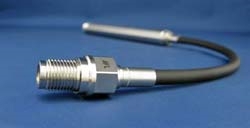Continuous engine performance monitoring

As part of the company's new Green Ship strategy, Kongsberg Maritime has announced that it is working with Austrian power train and instrumentation specialist, AVL. Through this collaboration Kongsberg Maritime will integrate AVL's sophisticated new sensor technology with its own vessel management systems. The goal of the partnership is to provide a continuous engine performance monitoring system in order to increase vessel fuel efficiency whilst reducing fuel costs.
With the increasing costs of fuels - combined with the taxation charges for emissions for CO2, NOx and SOx - the demands from the market for ways to analyse and, in turn, improve an engine's performance continue to grow rapidly. To date, the ability to create fuel savings of even a few percent, which can equate to savings of tens of thousands of dollars a year, has been limited as current sensor technology cannot provide optimal engine efficiency through continuous monitoring.
Up to 600 °C
AVL's new sensors however, which the company developed as part of its engine performance & optimisation system (AVL EPOS) are based on gallium orthophosphate crystals, which can operate in temperatures up to 600 °C, as opposed to traditional quartz crystal sensors that can only operate up to around 275 °C. This makes it possible for the first time to provide continuous engine performance monitoring.
Kongsberg Maritime has enabled AVL to bring this technology to the marine world, and will be offering continuous engine performance monitoring through its integrated systems, such as the K-Chief automation system, MBB VDR and the FleetMaster electronic logbook. Traditional engine performance monitoring systems have required manual intervention; however AVL's approach is completely different and, when combined with Kongsberg Maritime's control systems experience, will bring about a sea change in engine performance management techniques.
Continues monitoring
"Unlike previous systems, our sensors are fitted to points on the engines and remain there throughout their lifetime. This means that they are able to continuously monitor the engine's performance and constantly provide detailed analysis of the situation whenever required," explains Dr. Ruediger Teichmann, AVL's global business segment manager, combustion measurement division. "We are very proud of the work we have done in being able to develop these new crystal sensors and Kongsberg Maritime's knowledge of the shipping sector means they understand the value of such a technology."
The AVL EPOS with the new sensor technology and Kongsberg Maritime's integrated systems are currently working together onboard Höegh Autoliners' 6,100 vehicle capacity car carrier, the HÖEGH DETROIT - AKA, the Green Ship Project. Although it is a complex system, the interface is simple, meaning that a broader range of crewmembers can use it. It uses a practical 'traffic light' system to notify crew of any performance problems. This information is currently used onboard and sent manually to the shore office. However, as the trial continues automatic reporting to the shore office via Inmarsat will be implemented.
Fuel savings
Morten Olsen, Sales & Marketing Manager of Kongsberg Maritime Europe and America, is particularly impressed with the pace of development of the partnership. "Our two companies have worked extremely well in a short timeframe to bring our complementary skills to bear on a challenging problem. With environmental concerns and fuel savings being at the top of every shipowner's agenda, I believe together we have swiftly created a product that can have a major positive impact on any vessel's green performance."